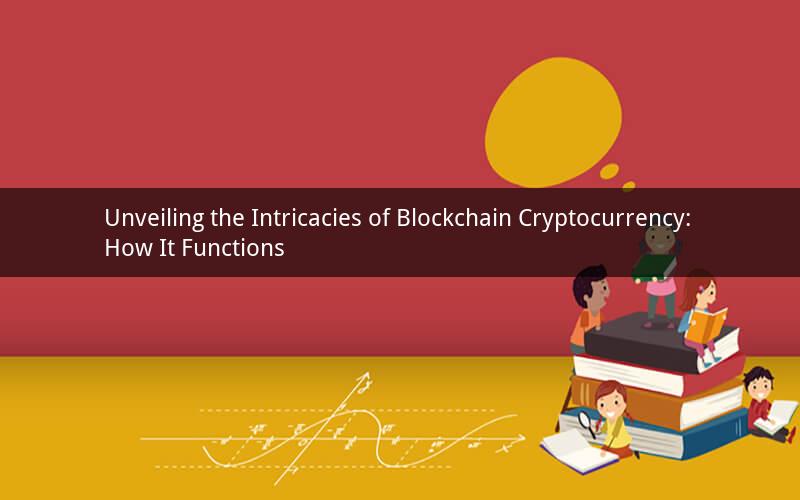
Blockchain technology has revolutionized the financial industry, and cryptocurrency has emerged as one of its most significant applications. In this article, we will explore how blockchain cryptocurrency works, its underlying principles, and its impact on the global economy.
1. What is Blockchain?
Blockchain is a decentralized digital ledger that records transactions across multiple computers. It ensures the security, transparency, and immutability of data. Unlike traditional ledgers, which are maintained by a single entity, blockchain operates on a peer-to-peer network, making it nearly impossible to alter or delete records.
2. How Does Blockchain Work?
The blockchain operates through a series of interconnected blocks, each containing a set of transactions. These blocks are linked together in a chronological order, forming a chain. Here's a step-by-step explanation of how blockchain cryptocurrency works:
a. Transaction Creation
When a user wants to send cryptocurrency, they initiate a transaction. This transaction includes the sender's and receiver's public keys, the amount of cryptocurrency being transferred, and a unique transaction ID.
b. Transaction Verification
Once a transaction is created, it is broadcasted to the network. Miners, who are responsible for validating transactions, receive this information. They use complex algorithms to verify the transaction's authenticity and ensure that the sender has sufficient cryptocurrency to transfer.
c. Block Creation
After verifying the transaction, miners compile multiple transactions into a block. This block contains a unique cryptographic hash, which links it to the previous block in the chain. The hash is generated using the contents of the block, including the transaction data and the hash of the previous block.
d. Mining and Consensus
Miners compete to solve a complex mathematical puzzle that validates the block's contents. The first miner to solve the puzzle adds the block to the blockchain, and their reward is a certain amount of cryptocurrency. This process is known as mining, and it ensures that the blockchain remains secure and decentralized.
e. Block Validation and Addition
Once a block is added to the blockchain, it is validated by the network. Other nodes in the network confirm the block's authenticity and its connection to the previous block. If the block is valid, it is added to the blockchain, and the process repeats for the next set of transactions.
3. Cryptocurrency and Blockchain: The Relationship
Cryptocurrency is a digital or virtual currency that uses cryptography to secure transactions and control the creation of new units. Blockchain is the technology that powers cryptocurrency, providing a secure and transparent platform for transactions.
4. Advantages of Blockchain Cryptocurrency
a. Security: The decentralized nature of blockchain makes it extremely secure. The vast network of nodes ensures that no single entity can control or manipulate the system.
b. Transparency: Every transaction on the blockchain is visible to all participants, promoting trust and accountability.
c. Immutability: Once a transaction is added to the blockchain, it cannot be altered or deleted. This ensures the integrity of the data.
d. Lower Transaction Costs: Blockchain eliminates the need for intermediaries, such as banks, reducing transaction costs.
5. Challenges and Concerns
a. Scalability: As the number of transactions increases, the blockchain's performance may suffer. This has led to the development of alternative technologies, such as sidechains and sharding.
b. Energy Consumption: Mining requires a significant amount of energy, raising concerns about the environmental impact of blockchain technology.
c. Regulatory Challenges: Cryptocurrency and blockchain are still relatively new, and governments around the world are still figuring out how to regulate these technologies.
Q1: How does blockchain ensure the security of cryptocurrency transactions?
A1: Blockchain ensures security through its decentralized nature, complex cryptographic algorithms, and the consensus mechanism used by miners to validate transactions.
Q2: What is the role of miners in the blockchain process?
A2: Miners validate transactions, create new blocks, and add them to the blockchain. They are rewarded with cryptocurrency for their efforts.
Q3: Can blockchain technology be used for applications other than cryptocurrency?
A3: Yes, blockchain technology has various applications beyond cryptocurrency, such as supply chain management, voting systems, and healthcare.
Q4: What are the potential environmental impacts of blockchain mining?
A4: Blockchain mining consumes a significant amount of energy, which can lead to increased carbon emissions and environmental degradation.
Q5: How can governments regulate blockchain and cryptocurrency without stifling innovation?
A5: Governments can regulate blockchain and cryptocurrency by creating a balanced regulatory framework that addresses security concerns while fostering innovation and growth.